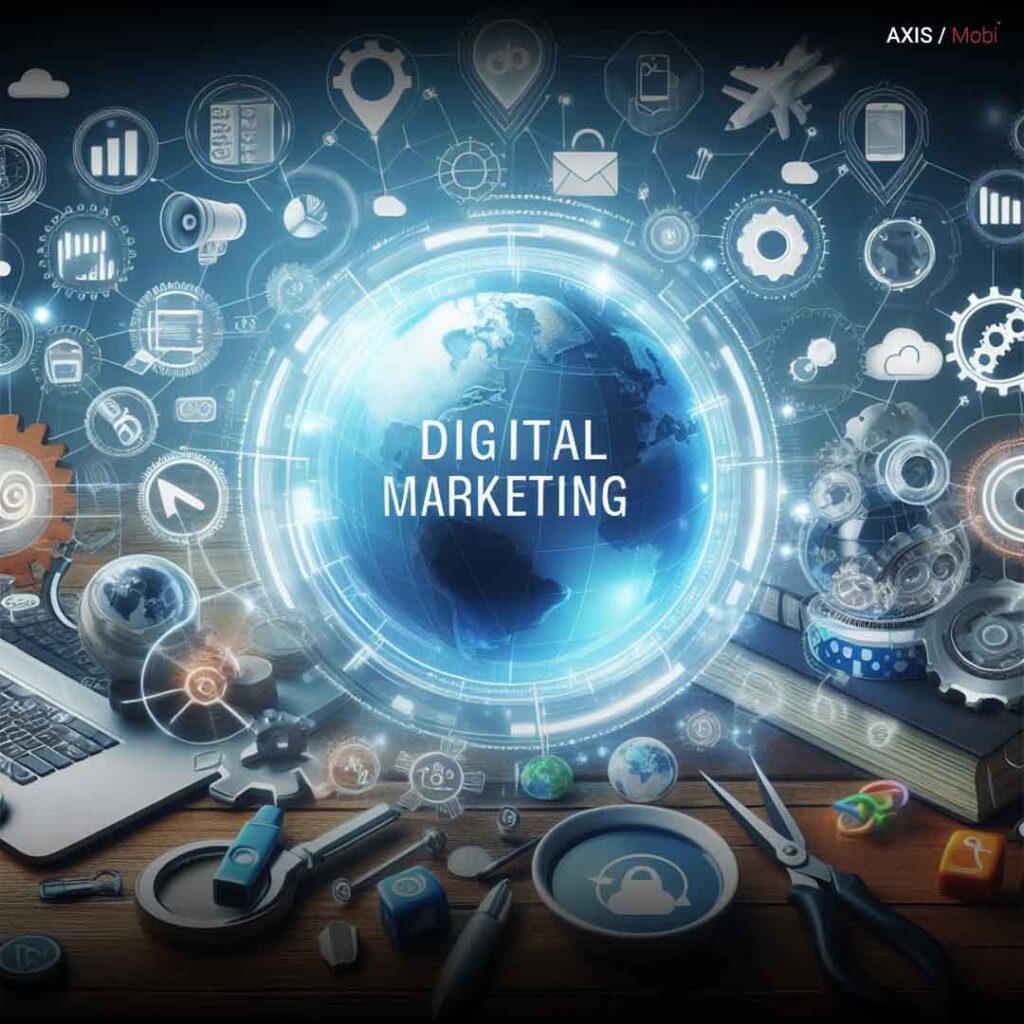In the fast-paced world of digital marketing, understanding the terminology and jargon is crucial for success. Whether you’re a student looking to enter the field or an aspiring marketer aiming to enhance your knowledge, having a comprehensive digital marketing glossary at your disposal is essential. In this curated guide, we will demystify the language of digital marketing and provide you with a valuable resource to navigate the exciting and ever-evolving landscape of online marketing.
Introduction to Digital Marketing

Digital marketing encompasses a wide range of strategies and tactics aimed at promoting products, services, or brands through digital channels. These digital channels include websites, search engines, social media platforms, email, mobile apps, and more. To embark on our journey into the world of digital marketing, let’s start with some fundamental terms.
1. Digital Marketing: The umbrella term for all marketing efforts conducted through digital channels, such as websites, search engines, email, social media, and mobile apps.
2. Online Marketing: Another term used interchangeably with digital marketing, referring to marketing activities carried out on the internet.
3. E-commerce: The buying and selling of products or services online, often through a website or app.
4. B2B (Business-to-Business) Marketing: Marketing strategies and tactics directed at other businesses or organizations, rather than individual consumers.
5. B2C (Business-to-Consumer) Marketing: Marketing strategies and tactics targeted at individual consumers.
The Digital Marketing Landscape

The digital marketing landscape is diverse, encompassing various channels and strategies. Understanding these channels and how they work is crucial for effective digital marketing. Let’s explore some essential terms related to the digital marketing landscape.
- Website: A collection of web pages hosted on the internet that provides information about a person, company, or topic.
- Search Engine: A software system that enables users to search for information on the internet. Examples include Google, Bing, and Yahoo.
- Search Engine Optimization (SEO): The process of optimizing a website to improve its visibility and ranking in search engine results pages (SERPs).
- Search Engine Marketing (SEM): A form of online advertising that promotes websites by increasing their visibility in search engine results through paid advertising.
- Pay-Per-Click (PPC): An online advertising model in which advertisers pay a fee each time their ad is clicked. It’s commonly associated with search engine advertising.
- Social Media Marketing: The use of social media platforms like Facebook, Twitter, Instagram, and LinkedIn to connect with audiences and promote products or services.
- Content Marketing: Creating and distributing valuable, relevant, and consistent content to attract and engage a target audience.
- Email Marketing: Sending targeted email campaigns to a group of recipients to promote products, services, or share information.
- Affiliate Marketing: A performance-based marketing strategy where businesses reward affiliates (partners) for driving traffic or sales to the business’s products or services through the affiliate’s marketing efforts.
- Influencer Marketing: Collaborating with influential individuals or “influencers” on social media to promote products or services to their followers.
Metrics and Analytics

Analyzing data is a fundamental aspect of digital marketing. Marketers use various metrics to measure the success of their campaigns and strategies. Understanding these metrics is crucial for making data-driven decisions.
- Click-Through Rate (CTR): The ratio of clicks on an ad or link to the number of times it was shown. It’s often used to measure the effectiveness of online advertising campaigns.
- Conversion Rate: The percentage of website visitors who take a desired action, such as making a purchase or filling out a contact form.
- Bounce Rate: The percentage of visitors who navigate away from a website after viewing only one page.
- Impressions: The number of times an ad or piece of content is displayed, regardless of whether it’s clicked or not.
- Click-Through Conversion: The number of conversions (e.g., purchases, sign-ups) that occur as a result of clicks on an ad.
- Customer Acquisition Cost (CAC): The cost incurred by a business to acquire a new customer through marketing efforts.
- Return on Investment (ROI): A measure of the profitability of a marketing campaign or investment, expressed as a percentage.
- Key Performance Indicator (KPI): Specific metrics that are used to evaluate the success of a campaign or marketing effort.
Website Optimization

A well-optimized website is essential for a successful digital marketing strategy. These terms are related to improving website performance and user experience.
- User Experience (UX): The overall experience that a website or product provides to its users, including ease of use and satisfaction.
- Responsive Design: A design approach that ensures a website adapts and displays correctly on various devices and screen sizes, including mobile phones and tablets.
- Loading Speed: The time it takes for a web page to fully load in a user’s browser. Faster loading speeds are generally preferred for better user experience and SEO.
- Mobile Optimization: The process of optimizing a website for mobile devices to ensure it functions and looks well on smartphones and tablets.
- A/B Testing: A method of comparing two versions of a webpage or marketing campaign to determine which one performs better.
- Landing Page: A specific web page created for a marketing campaign, often with a focused call to action (CTA).
Social Media Terminology

Social media platforms are integral to digital marketing strategies. Understanding the terminology used on these platforms is essential for effective social media marketing.
- Social Media Profile: A user’s personal or business page on a social media platform.
- Engagement: The level of interaction and activity that users have with a brand’s social media content, including likes, comments, shares, and clicks.
- Hashtag: A keyword or phrase preceded by the “#” symbol used on social media platforms to categorize and discover content related to a specific topic.
- Reach: The total number of people who see a particular post or piece of content on social media.
- Algorithm: The set of rules or calculations used by social media platforms to determine which content is shown to users in their feeds.
Email Marketing Essentials

Email marketing remains a highly effective digital marketing channel. Here are key terms related to email marketing.
- Email List: A collection of email addresses used to send marketing messages and updates to subscribers.
- Open Rate: The percentage of recipients who opened an email message.
- Click-Through Rate (CTR): The percentage of email recipients who clicked on one or more links contained in an email message.
- Conversion Rate: The percentage of email recipients who completed a desired action, such as making a purchase or filling out a form.
- Segmentation: The process of dividing an email list into smaller groups based on specific criteria, such as demographics or behavior.
- Autoresponder: A series of pre-scheduled email messages sent automatically to subscribers at specific intervals.
Content Marketing Concepts

Creating valuable and relevant content is a cornerstone of digital marketing. These terms are related to content marketing.
- Evergreen Content: Content that remains relevant and valuable to the audience over an extended period, often not tied to specific events or trends.
- Call to Action (CTA): A prompt or instruction that encourages readers or viewers to take a specific action, such as signing up for a newsletter or making a purchase.
- Guest Blogging: Writing and publishing articles or blog posts on external websites to reach a broader audience and establish authority.
- Content Calendar: A schedule that outlines the planned content to be created and published over a specified period.
Pay-Per-Click (PPC) Advertising Terms
PPC advertising allows businesses to bid for ad placement in search engine results and on various advertising platforms. Understanding these terms is essential for effective PPC campaigns.
- Ad Campaign: A set of ads grouped together with a common goal, budget, and targeting criteria.
- Click-Through Rate (CTR): The percentage of ad viewers who clicked on the ad.
- Cost Per Click (CPC): The amount an advertiser pays each time a user clicks on their ad.
- Quality Score: A metric used by search engines to evaluate the quality and relevance of an ad, keywords, and landing page.
SEO Terms
Search Engine Optimization (SEO) is a critical component of digital marketing. These terms are essential for understanding SEO strategies.
- Backlink: A hyperlink from one website to another, considered a crucial factor in SEO.
- Keyword: A specific word or phrase that users enter into a search engine to find relevant content.
- On-Page SEO: The optimization of individual web pages to improve their search engine rankings and visibility.
- Off-Page SEO: Activities conducted outside of a website to improve its search engine rankings, such as link building and social media marketing.
Analytics and Reporting
Analyzing data and performance metrics is central to digital marketing. These terms relate to analytics and reporting.
- Analytics: The process of collecting, measuring, and analyzing data to understand and optimize performance.
- Conversion Rate: The percentage of visitors who take a specific action, such as making a purchase or filling out a form.
- Bounce Rate: The percentage of website visitors who leave a site after viewing only one page.
- Traffic Sources: The channels through which visitors arrive at a website, such as organic search, paid search, social media, and direct traffic.
- Key Performance Indicator (KPI): Specific metrics used to evaluate the effectiveness of a campaign or marketing effort.
Advertising and Promotion
Digital marketing often involves paid advertising and promotional activities. These terms are relevant to online advertising.
- Ad Impressions: The number of times an ad is displayed to users.
- Ad Clicks: The number of times users click on an ad.
- Cost Per Mille (CPM): The cost of 1,000 ad impressions in an advertising campaign.
- Click-Through Rate (CTR): The percentage of users who clicked on an ad.
- Ad Copy: The text and content used in an advertisement
Social Media Advertising Terms
Paid advertising on social media platforms is a popular digital marketing strategy. These terms are associated with social media advertising.
- Boosted Post: Paying to promote a regular social media post to a wider audience.
- Ad Targeting: Selecting specific criteria, such as demographics and interests, to display ads to a defined audience.
- Ad Campaign Budget: The total amount allocated for a specific social media advertising campaign.
- Click-Through Rate (CTR): The percentage of users who clicked on a social media ad.
- Ad Placement: Where an ad is displayed on a social media platform, such as in users’ feeds, stories, or on the sidebar.
Frequently Asked Questions (FAQs)
-
What is digital marketing?
Digital marketing is an umbrella term encompassing marketing efforts conducted through digital channels, such as websites, search engines, social media, email, and mobile apps. It aims to promote products, services, or brands online.
-
How does search engine optimization (SEO) work?
SEO involves optimizing a website to improve its visibility in search engine results. This is achieved through various strategies, including keyword optimization, content creation, and improving user experience to rank higher on search engine results pages (SERPs).
-
What is the difference between B2B and B2C marketing?
B2B (Business-to-Business) marketing focuses on businesses and organizations, while B2C (Business-to-Consumer) marketing targets individual consumers. The strategies and tactics employed vary based on the target audience.
-
What does PPC stand for, and how does it work?
PPC stands for Pay-Per-Click. It’s an online advertising model where advertisers pay a fee each time their ad is clicked. Advertisers bid for ad placement, and ads are displayed based on relevance and bid amount.
-
How does social media marketing contribute to digital strategies?
Social media marketing involves using platforms like Facebook, Twitter, Instagram, and LinkedIn to connect with audiences, build brand awareness, and promote products or services through engaging content and interactions.
-
What are the key metrics in email marketing?
Key metrics in email marketing include Open Rate (percentage of opened emails), Click-Through Rate (percentage of clicks on links), Conversion Rate (percentage of desired actions), and List Segmentation (dividing email lists based on specific criteria).
-
What is the significance of backlinks in SEO?
Backlinks are hyperlinks from one website to another. They are crucial in SEO as search engines consider them as a vote of confidence. Quality backlinks contribute to a website’s authority and influence its search engine rankings.
-
How does A/B testing enhance digital marketing strategies?
A/B testing involves comparing two versions of a webpage or campaign to determine which performs better. It helps marketers make data-driven decisions by analyzing user behavior and preferences for optimal results.
-
What is the role of analytics in digital marketing?
Analytics involves collecting and analyzing data to understand and optimize performance. In digital marketing, it helps marketers track key metrics, make informed decisions, and measure the success of campaigns.
-
How do social media advertising terms like CPM and CTR impact campaigns?
CPM (Cost Per Mille) represents the cost of 1,000 ad impressions, while CTR (Click-Through Rate) indicates the percentage of users who clicked on an ad. Both metrics influence the effectiveness and cost efficiency of social media advertising campaigns.
-
What is a landing page in digital marketing?
A landing page is a specific web page created for a marketing campaign with a focused call to action. It is designed to encourage visitors to take a particular action, such as making a purchase or filling out a form.
-
How does evergreen content contribute to content marketing?
Evergreen content remains relevant and valuable over an extended period. In content marketing, it provides enduring value to the audience, attracting traffic consistently and contributing to long-term SEO benefits.
-
What is the purpose of ad targeting in social media advertising?
Ad targeting involves selecting specific criteria, such as demographics and interests, to display ads to a defined audience. This ensures that ads reach users who are more likely to be interested in the products or services being promoted.
-
Why is mobile optimization important for websites?
Mobile optimization ensures that a website functions well and looks appealing on mobile devices. With the increasing use of smartphones, optimizing for mobile enhances user experience, improves SEO, and reaches a broader audience.
-
How do click-through rate (CTR) and conversion rate differ in digital marketing?
CTR measures the percentage of users who clicked on an ad or link, indicating engagement. Conversion rate, on the other hand, represents the percentage of visitors who completed a desired action, such as making a purchase or filling out a form, reflecting successful outcomes.
-
What is user experience (UX) in the context of digital marketing?
User Experience (UX) refers to the overall experience that a website or product provides to its users, including ease of use, satisfaction, and accessibility. A positive UX is crucial for retaining visitors and achieving digital marketing goals.
-
How does content calendar contribute to content marketing strategies?
A content calendar is a schedule outlining planned content creation and publication. It helps content marketers organize and plan their efforts, ensuring a consistent flow of valuable content aligned with business goals and audience needs.
-
What is the significance of a Quality Score in PPC advertising?
Quality Score is a metric used by search engines to evaluate the quality and relevance of an ad, keywords, and landing page. A higher Quality Score positively impacts ad placement and lowers the cost per click (CPC) in PPC advertising.
-
Why is segmentation important in email marketing?
Segmentation involves dividing an email list into smaller groups based on specific criteria. It allows marketers to send targeted and personalized messages, improving relevancy and increasing the chances of engagement and conversions.
-
How does PPC advertising differ from organic search in digital marketing?
PPC advertising involves paid placement in search engine results, with advertisers paying per click. Organic search, however, relies on optimizing content and website elements to naturally rank higher in search engine results without direct payment.





Pingback: Misunderstood Digital Marketing Terms: Clear Definitions